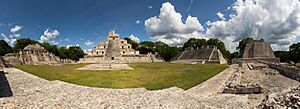Edzna facts for kids
 |
|
| Lua error in Module:Location_map at line 420: attempt to index field 'wikibase' (a nil value). | |
| Alternative name | House of the Itzaes |
|---|---|
| Location | Campeche, |
| History | |
| Material | Limestone |
| Abandoned | c. 1500 AD |
| Cultures | Maya |
| Site notes | |
| Discovered | 1907 |
| Excavation dates | 1958- |
| Public access | yes |
Edzná is an ancient Maya city. It is an archaeological site in the northern part of the Mexican state of Campeche. The site has been open for visitors since the 1970s. Its name, Edzná, means "House of the Itzaes."
Contents
Edzná: An Ancient Maya City
Edzná was a very important city for the Maya people. It was first settled around 400 BC, which is a very long time ago! It grew into a major city by 200 AD. The city was abandoned around 1500 AD, and why it was left remains a mystery today.
Exploring the Main Buildings
The most amazing building at Edzná is the main temple. It stands tall on a platform that is 40 meters (about 130 feet) high. From the top, you can see a wide view of the entire area. Imagine what it was like for the ancient Maya to stand up there!
Another important building in the main plaza is the ball court. This court has two parallel structures. The Maya played a special ball game here. The rooms at the top of the ball court might have been used to keep statues of gods or items for the games.
A Glimpse into Edzná's Past
During its busiest times, Edzná had a government. The leaders believed their power came from the gods. This connection to the gods made their rule strong.
In the Late Classic period (a later time in Maya history), Edzná was part of the powerful Calakmul kingdom. This shows how important Edzná was in the Maya world.
You can see a special building style at Edzná called the Puuc style. This is interesting because Edzná is quite far from other sites that use this style. It shows how ideas and building methods spread across the Maya lands.
How Edzná Was Found
People first discovered Edzná in 1907. Later, in 1958, organized teams started to dig and explore the site. This work helped us learn more about the ancient city and its people.
See also
 In Spanish: Edzná para niños
In Spanish: Edzná para niños



